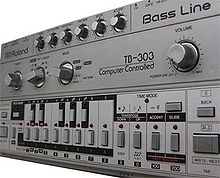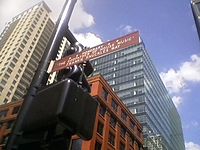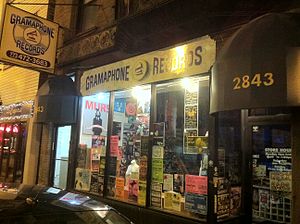- Chicago house
-
Chicago house Stylistic origins House
Post-disco
Synthpop
Dub
Old school hip hop
R&B
Jazz
Latin soulCultural origins Early 1980s; Chicago, U.S. Typical instruments Sampler • Drum machine/Drums • Synthesizer • Sequencer Derivative forms Detroit techno • Techno Fusion genres Deep house, Acid House Chicago house is a style of house music, a genre of electronic dance music which emerged in Chicago in the mid-1980s. Stylistically, Chicago house has no widely accepted definition, but generally includes the first house music productions by Chicago-based artists throughout the 1980s, and any later house music, regardless of geographic origin, which more closely emulates the early Chicago artists' styles more than any others. Chicago house tracks may also be in the acid house, hip house, deep house, or garage house genres.
Contents
History
Disco edits
Following Chicago's Disco Demolition Night in mid-1979, disco music's mainstream popularity fell into decline. In the early 1980s, fewer and fewer disco records were being released, but the genre remained popular in some Chicago nightclubs and on at least one radio station, WBMX-FM.
In this era, Chicago radio jocks The Hot Mix 5 and club DJs like Ron Hardy, Frankie Knuckles, and Marshall Jefferson played various styles of dance music, including older disco records, newer Italo Disco, hip hop and electro funk tracks, as well as electronic pop music by Kraftwerk and Yellow Magic Orchestra, and recent danceable R&B productions in the genre now known as boogie.
Some of these DJs also made and played their own edits of their favorite songs on reel-to-reel tape, focusing on the portions of songs which worked well on the dancefloor. Some even mixed in effects, drum machines, and other rhythmic electronic instrumentation in an effort to give songs more appeal. These edits and remixes were rarely released to the public, and even then were available only on privately pressed vinyl records or on mixtapes.
Original productions
One DJ, Jesse Saunders, ran a vanity record label through which he released original dance music productions which emulated various popular styles of the day. In 1984, the label released, on 12-inch single, a song called "On and On". Saunders composed the track with Vince Lawrence in order to replace a record which had been stolen from Saunders' collection, the "On & On" bootleg disco megamix by Mach. That megamix, a pastiche of loops from several disco records, had been Saunders' "signature" tune as a DJ; it was one that other DJs in the city didn't have or didn't play. The version by Saunders & Lawrence wasn't a faithful cover, but had the same bassline, and added hypnotic lyrics and electronic percussion. In a 2010 interview, Saunders claimed the song sought to capture the essence of the style of disco that other local DJs were playing at the time, a style which he says was already known locally as "house".[1]
Saunders' success with the relatively unpolished "On & On" inspired other Chicago DJs to try their hand at producing and releasing original songs in a similar style, using electronic instrumentation. Early such recordings included Jamie Principle and Frankie Knuckles' "Your Love"; and Chip E.'s "The Jack Trax" record, featuring the songs “It’s House” and “Time to Jack”, each of which used complex rhythms, simple bassline, sampling technology, and sparse vocals.
 The Roland TB-303 bass synthesizer
The Roland TB-303 bass synthesizer
These producers were aided in their efforts by the availability of affordable, mass-produced electronic music instruments, including synthesizers, compact sequencers, drum machines (like the Roland TR-909, TR-808 and TR-707, and Latin percussion machine the TR-727) and bass modules (such as the Roland TB-303).
Although there are conflicting accounts of the term's etymology, by 1985, "house music" was synonymous with these homegrown dance music productions.
Increasing popularity and divergent styles
As with other dance music, DJs and local club-goers were the primary audience for this relatively noncommercial music, which was more conceptual and longer than the music usually played on commercial radio. Mainstream record stores often did not carry it, as the records were not available through the major record distributors. In Chicago, only record stores such as Importes Etc., State Street Records, JR’s Music shop and Gramaphone Records were the primary suppliers of this music. Despite the music's limited commercial availability, house records sold in the tens of thousands, and the music was further popularized via radio station 102.7 WBMX-FM, where Program Director Lee Michaels gave airtime to the station's resident DJ team, the Hot Mix 5 (Ralph Rosario, Mickey "Mixin" Oliver, Scott "Smokin" Silz, Kenny "Jammin" Jason, and Farley "Jackmaster" Funk). The Hot Mix 5 shows started with the station's launch in 1981, and was widely listened to by DJs and dance music fans in Chicago as well as visiting DJs and producers from Detroit.[2]
Many of the songs that defined the Chicago house music sound were released primarily on vinyl by the labels DJ International Records and Trax Records, both of which had distribution outside of Chicago, leading to house's popularity in other cities, including New York and London.
Trends in house music soon became subgenres, such as the lush, slower-tempo deep house, and the stark, especially hypnotic acid house. Deep house's origins can be traced to Chicago producer Mr Fingers's relatively jazzy, soulful recordings "Mystery of Love" (1985) and "Can You Feel It?" (1986). Acid house arose from Chicago artists' experiments with the squelchy Roland TB-303 bass synthesizer, and the style's earliest release on vinyl is generally cited as Phuture's "Acid Trax" (1986).
Several house tracks became #1 hits on the UK Singles Chart, starting with Chicago musician Steve 'Silk' Hurley's "Jack Your Body" (1987). Music was being licensed to UK Labels by DJ International, Tracks, KMS and the Transmat record labels, and with that the music began to expand throughout Europe as many homegrown UK artist, DJ's and producers began to have their own releases influenced by the Chicago and Detroit music they were importing.
Mr. Lee (Lee Haggard) & Kompany released Shoot Your Best Shot on Mitchbal Records which was owned, and operated by Vince Lawrence's father. A conglomeration of Chicago artists, producers, and engineers put together by Tony Mundaca, and Brett Wilcots (both former employees at Importes Etc. record store, and IRS Record pool) Shoot Your Best Shot incorporated hard rock guitar laden electro boogie styles into the house track "Shoot Your Best Shot" which went virtually unnoticed for some time, however Mr. Lee would later go on to achieve #1 Billboard club chart status with his monumental track "Get Busy" Mr. Lee also produced many other successful Chicago House Music tracks.
House Dance
At least three styles of dancing are associated with house music: Footwork, Jacking, and Lofting.[citation needed] These include a variety of techniques and sub-styles, including skating, stomping, and shuffling.[citation needed] House music dancing styles can include movements from many other forms of dance, such as whacking, voguing, African, Latin, Brazilian (including Capoeira), jazz, Lindy era, tap, and even modern.[citation needed]. House dancing is concerned with the sensuality of the body and setting oneself free—without the worry of outside barriers.
One of the primary elements in house dancing is a technique that came from Chicago that involves moving the torso forward and backward in a rippling motion, as if a wave were passing through it. When this movement is repeated and sped up to match the beat of a song it is called jacking, or "the jack". All footwork in house dancing is said to initiate from the way the jack moves the center of gravity through space.[3]
See also
- Acid house
- Adonis
- Chicago record labels
- Curtis Jones (Cajmere/Green Velvet)
- Derrick Carter
- DJ Sneak
- Frankie Knuckles
- Larry Heard
- Marshall Jefferson
- Ten City
- Trax Records
- Mark Farina
- Chip E
- Jesse Saunders
- Farley Keith
- Ron Hardy
- Paul Johnson
- Phuture
- DJ Pierre
- DJ Funk
- Joe Smooth
- Kaskade
- DJ Colette
- Felix da Housecat
- Bad Boy Bill
- Armando
- Ralphi Rosario
- Lil Louis
- Paris Grey
- Steve Hurley
- Hot Mix 5
- Fast Eddie
- Dajae
- Roy Davis, Jr.
- Maurice Joshua
- Eric Miller
- Robert Owens
- Fingers, Inc.
- Jamie Principle
- Vince Lawrence
References
- ^ Church, Terry (2010-02-09). "Black History Month: Jesse Saunders and house music". BeatPortal. http://www.beatportal.com/feed/item/black-history-jesse-saunders-and-house-music/. Retrieved 2010-04-10.
- ^ Hoffman, Heiko (2005-11-28). "From The Autobahn to I-94". http://pitchfork.com/features/articles/6204-from-the-autobahn-to-i-94/. Retrieved 2010-04-11.
- ^ Reynolds, Simon. Generation Ecstasy. Little, Brown & Co., 1998, pp. 29–31.
External links
- History of Chicago House Music
- Chicago House Radio
- 5 Magazine - Chicago House Music magazine
- WBMX Hot Mix 5 Classics radio - regularly plays popular old school Chicago house tracks, among other Dance tracks (aproximatively 1/3 for European Italo Disco/Hi-Nrg, Latin Freestyle and US Disco according to the Chicago's population breakdown: 1/3 per white, Latin and black - thanks to God for idea - which are the base of Chicago House).
House Associated genres Regional genres Related topics Discothèque · DJ · Nightclub
Categories:- House music genres
- Culture of Chicago, Illinois
- Music scenes
Wikimedia Foundation. 2010.


